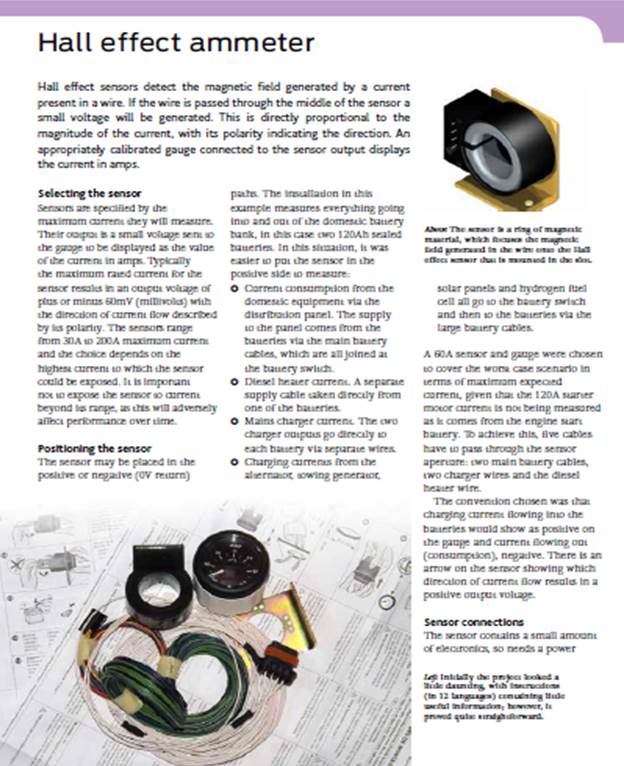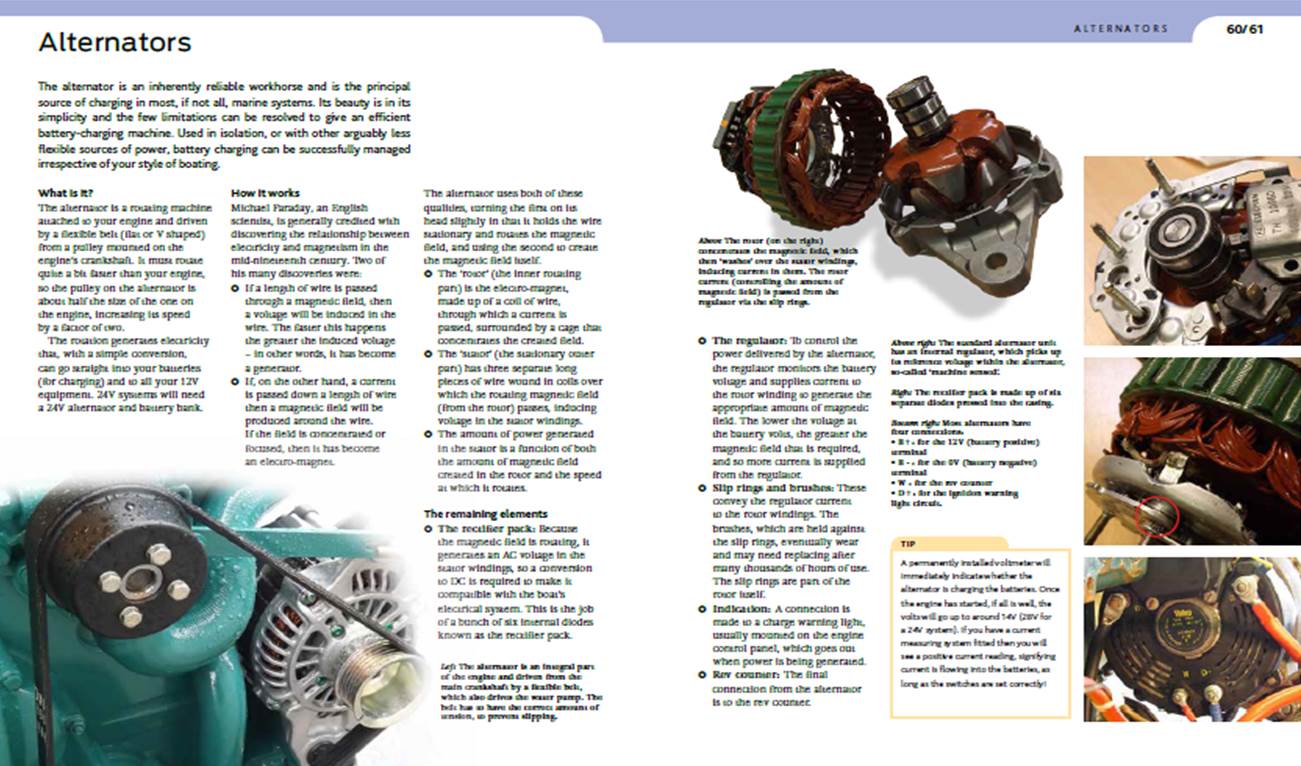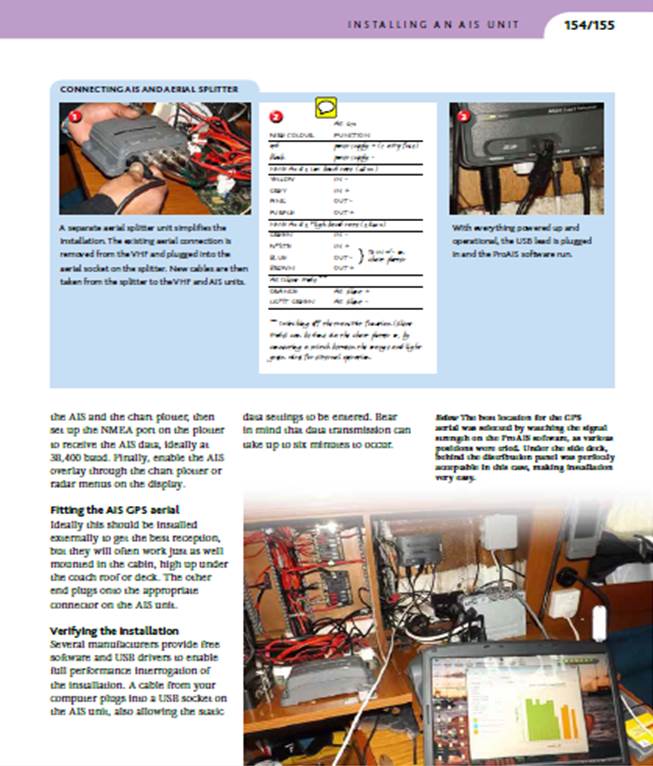Some samples of the book's content. Each topic is a double page spread concisely written .
The Boat Electrics Bible
If you have never attempted electrical work on a boat or are at best, reluctant to try, this book attempts to take the mystery out of the wires, switches, fuses and other parts associated with the boat’s battery powered, low voltage electrical equipment. Ultimately it is just another vessel system and with some detailed explanations, you can gain sufficient insight into how it all works.
Safety is always paramount and all aspects of working on boats have their potential dangers. The low voltage battery based (12 Volt and 24 Volt) electrical systems are inherently safe but care is necessary because the batteries store a substantial amount of energy. Although having mains electricity on board is discussed, working on that high voltage system is not covered in any detail.
The book examines all aspects of battery based, low voltage electrics that you are likely to find on your boat. It is as practical as possible, keeping the background theory to the minimum necessary to understand why certain things happen, or are tackled in a particular way. The main focus is to understand what is necessary to install a new piece of equipment and how to find and rectify problems or faults in existing systems.
The concepts of voltage, current, resistance and power are discussed in detail because they are fundamental to the functioning of electrical systems.
Without sufficient voltage, the equipment may not operate correctly.
The correct wire size and most appropriate fuse arrangement, to protect the wiring, can both be established based on the operating current consumed by the equipment.
The operating current can be derived either by measurement or from the power consumption printed on the equipment itself or in its operating manual.
Since the whole low voltage system depends on the batteries, a thorough understanding of the different types available, how many you might need and how they work is important. Although they are low maintenance items, the way in which they are used and recharged will influence their performance and lifespan. From the batteries, individual circuits ultimately feed electrical power to the many pieces of equipment on the vessel. Between the batteries and the equipment is an arrangement of switches, fuses, distribution panels, indicator lights and, of course, a mass of wire. There may be only one means of recharging the batteries on board, your engine (or at least the alternator attached to the engine), or a whole raft of sources including shore power, solar, wind and water. The management and regulation of these is very important and is covered in detail.
Finally, the book looks at the communication between instruments, radar, AIS and other aids to navigation and systems monitoring. The various networks available, particularly NMEA0183 and NMEA2000 (or manufacturer’s equivalents) are examined in theory and in practical examples. Instruments can be linked together from different manufacturers, utilising both types of network either separately or simultaneously.
Once you are familiar with the concepts and have an understanding of what your objectives are, the low voltage electrical systems present no more or less difficulty than anything else on your boat.
The Boat Electrics Bible
If you have never attempted electrical work on a boat or are at best, reluctant to try, this book attempts to take the mystery out of the wires, switches, fuses and other parts associated with the boat’s battery powered, low voltage electrical equipment. Ultimately it is just another vessel system and with some detailed explanations, you can gain sufficient insight into how it all works.
Safety is always paramount and all aspects of working on boats have their potential dangers. The low voltage battery based (12 Volt and 24 Volt) electrical systems are inherently safe but care is necessary because the batteries store a substantial amount of energy. Although having mains electricity on board is discussed, working on that high voltage system is not covered in any detail.
The book examines all aspects of battery based, low voltage electrics that you are likely to find on your boat. It is as practical as possible, keeping the background theory to the minimum necessary to understand why certain things happen, or are tackled in a particular way. The main focus is to understand what is necessary to install a new piece of equipment and how to find and rectify problems or faults in existing systems.
The concepts of voltage, current, resistance and power are discussed in detail because they are fundamental to the functioning of electrical systems.
Without sufficient voltage, the equipment may not operate correctly.
The correct wire size and most appropriate fuse arrangement, to protect the wiring, can both be established based on the operating current consumed by the equipment.
The operating current can be derived either by measurement or from the power consumption printed on the equipment itself or in its operating manual.
Since the whole low voltage system depends on the batteries, a thorough understanding of the different types available, how many you might need and how they work is important. Although they are low maintenance items, the way in which they are used and recharged will influence their performance and lifespan. From the batteries, individual circuits ultimately feed electrical power to the many pieces of equipment on the vessel. Between the batteries and the equipment is an arrangement of switches, fuses, distribution panels, indicator lights and, of course, a mass of wire. There may be only one means of recharging the batteries on board, your engine (or at least the alternator attached to the engine), or a whole raft of sources including shore power, solar, wind and water. The management and regulation of these is very important and is covered in detail.
Finally, the book looks at the communication between instruments, radar, AIS and other aids to navigation and systems monitoring. The various networks available, particularly NMEA0183 and NMEA2000 (or manufacturer’s equivalents) are examined in theory and in practical examples. Instruments can be linked together from different manufacturers, utilising both types of network either separately or simultaneously.
Once you are familiar with the concepts and have an understanding of what your objectives are, the low voltage electrical systems present no more or less difficulty than anything else on your boat.
JWMarine







